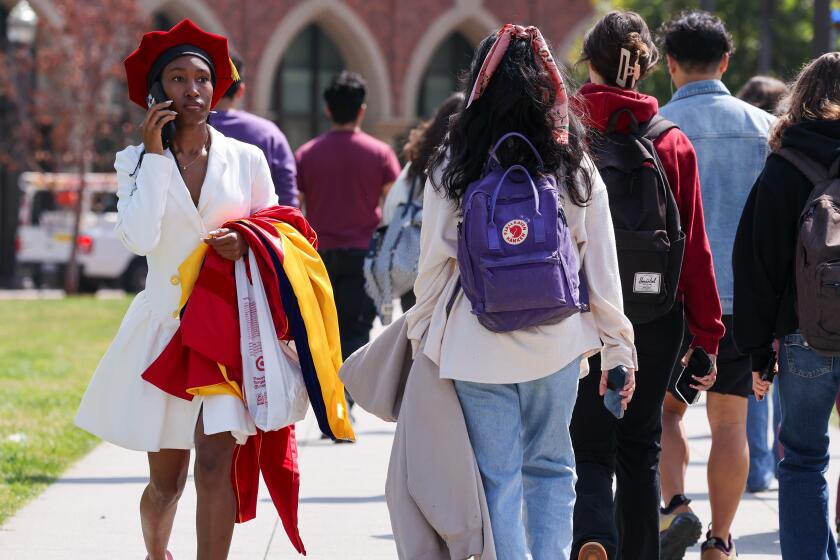Students Feel the Heat of Crowding, Budget Cuts in 1st Week of School
By 11 a.m. Friday, the temperature inside Larry Merken’s physiology classroom at Taft High School was 90 degrees and climbing.
“It’ll be at least 102 in here before the day’s over,” the veteran teacher said above the whir of four small electric fans. “How can the students be expected to learn?”
Students and teachers not only perspired through a hot and muggy first week of year-round school but found themselves struggling to overcome low morale and adjust to a new order of austerity brought on by drastic budget cuts affecting schools throughout the Los Angeles Unified School District.
A close-up look at 3,119-student Taft, for example, shows that 13 teachers are gone, causing an increase in class size at the Woodland Hills campus. One counselor position also was cut. School supplies were restricted, and students in some classes are sharing books.
The swim team, junior varsity sports teams and the cheerleaders who support them have been eliminated. The varsity cheerleading squad will only appear at home games, because only one bus is available for matches played on other campuses and it will transport the football team.
Unprecedented state funding shortfalls have forced Los Angeles school officials to slash $274 million from this year’s $4-billion budget. Districtwide, more than 800 teaching positions have been eliminated, increasing class sizes.
Adding to the first-week-of-school woes, Taft, like most schools in the San Fernando Valley, lacks air-conditioning. “When you put 38 kids in a class, it is not an ideal situation,” said Principal Ron Berz, adding that only Kennedy and El Camino high schools are air-conditioned.
Berz said district policy for average classroom size for the 11th and 12th grades is 38.5 students and 35.5 for ninth and 10th grades.
But teachers said the average class size is closer to 40. “I don’t know how I’m going to conduct lab experiments with this many students,” said Merken of the 41 students in his third-period physiology class.
Creative-writing teacher Lynn Prager said she normally has 20 students in her class, but this year she has 31. “I cannot possibly offer the same level of teaching,” she said.
With 40 students in her crowded art classroom, Melanie Miller said she cannot give much individual attention. Until Friday morning, 17 of the students had no chairs, and students had had to sit on windowsills, cabinet counters, the floor, in the hallway, anywhere they could find space.
“There’s only room for about 30 students, but they have 40 of us crowded in here,” said student Brandi Marino, 16.
But Berz said a shortage of chairs in some classrooms is typical of the first week. Chairs are distributed according to enrollment through the first week of school, he said.
The principal said teachers are doing a good job of coping with fewer supplies, including photocopying on both sides of paper, instead of just on one side.
He predicted things will get better as the semester progresses. “The instruction is going on,” he said.
Frank Walbert, a Taft economics teacher, had 61 textbooks for 140 students in three classes. “I can’t let them take the books home,” he said. “I have to pass the books out and collect them at the end of class.”
Walbert said his smallest class this semester has 40 students, and “that’s an honors class.” Last year, his classes had 35 to 36 students.
As for the students, many carried water bottles and fans. They complained about the heat and bemoaned the loss of drama productions, debate teams, school magazines, junior varsity football and other after-school activities.
Student body president Delone Dyer, a 17-year-old senior, was concerned about sagging school spirit brought about by the loss of extracurricular activities.
“We’re trying to organize a pep rally Sept. 6,” she said. “Our school spirit is really low. We only have one night dance a year, and that’s homecoming. I wonder if we’ll have enough students to hold that.”
Ori Zemer, 16, said funds had been taken away for drama productions and that the yearbook and school newspaper have been scaled back. “But they didn’t take anything away from the football team,” he complained.
“With eight weeks between semesters, you forget everything you’ve learned the first semester,” said Bryan Kim, 17.
Several basketball team members said they feared they would not be a winning team this year because many of their games would be played during a winter school break. “Nobody will come to watch us play,” said Casey Sheahan, 17. “We’ll get no support.”
But most students said their worst problem was the heat and the crowding.
Ron Grinblat, 17, said, “You start sweating early in the morning, and you don’t stop.”
Adam James, 17, noted that the administration building is air-conditioned. “It doesn’t seem fair,” he said. “It’s impossible to teach or learn in 100-degree weather.”
On a brighter note, David Solokovitz, a geography teacher, said the absentee rate was low the first week of school. “I didn’t expect as many students to show up. We’re off and running,” he said.
And Spanish teacher Yolanda Dave said she reminds students about positive things at the school--the award-winning academic decathlon team and famous graduates such as astronaut Katherine Sullivan and professional baseball player Robin Yount of the Milwaukee Brewers.
“We have a lot to be proud of at Taft,” she said.
Times staff writers Julio Moran and Jim Herron Zamora contributed to this report.
More to Read
Start your day right
Sign up for Essential California for news, features and recommendations from the L.A. Times and beyond in your inbox six days a week.
You may occasionally receive promotional content from the Los Angeles Times.






